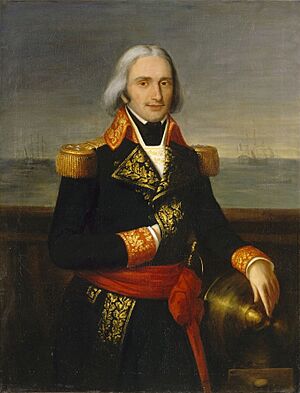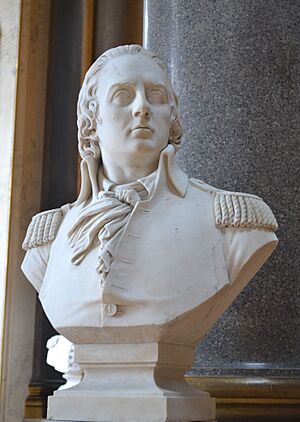François-Paul Brueys d'Aigalliers facts for kids
Quick facts for kids
François-Paul Brueys d'Aigalliers
|
|
|---|---|
 |
|
| Born | 12 February 1753 Uzès, Languedoc, France |
| Died | 1 August 1798 (aged 45) Abu Qir Bay, Eyalet of Egypt, Ottoman Empire |
| Allegiance | |
| Service/ |
|
| Years of service | 1766–1798 |
| Rank | Vice Admiral |
| Battles/wars | American Revolutionary War French Revolutionary Wars |
François-Paul Brueys d'Aigalliers (born 12 February 1753, died 1 August 1798) was a French naval officer. He fought in important wars like the American War of Independence and the French Revolutionary Wars. He became a Vice Admiral and led the French fleet during the Mediterranean campaign of 1798. He died during the famous Battle of the Nile.
Contents
Life of a French Admiral
François-Paul Brueys d'Aigalliers was born into a noble family in Uzès, southern France. He joined the navy when he was just 13 years old in 1766. His first ship was the Protecteur. He served in several campaigns in the Levant, which is the eastern Mediterranean region.
In 1768, he became a Garde de la marine, a type of naval cadet. He took part in the Tunis expedition on the frigate Atalante. He also served in the Saint Domingue campaign on the ship Actionnaire. However, he had to leave this ship due to illness and returned to France. He then worked at naval bases, mostly along France's Mediterranean coast.
Rising Through the Ranks
Brueys continued to advance in the navy. He became an enseigne de vaisseau (a junior officer) in 1777. In April 1780, he was promoted to lieutenant de vaisseau. He served on the ships Terrible and Zélé in Admiral Guichen's fleet.
He fought in three battles against Admiral Rodney in 1780. He was also part of the battle against Hood's fleet near Fort-de-France in 1781. Brueys was present at all the battles involving Admiral Grasse's fleet. These included the Battle of Chesapeake in September 1781. He also helped capture Saint Kitts in February 1782. He later moved to the frigate Vestale. By chance, he was not at the Battle of Les Saintes. At the end of the war, he was made a chevalier de Saint-Louis, which was an honor.
After the war, he commanded the ship Chien de Chasse. He spent four years sailing in the Antilles and off the American coast. In 1787, he commanded another ship, the Coureur. This ship sailed along the coasts of Latin America. He then returned to France and commanded the Barbeau. He took a year off from 1788 to 1789. In 1790, he commanded the corvette Poulette. He sailed her from Toulon to Algiers. He also carried important messages for French consuls in the Levant.
Service During the Revolution
During the Reign of Terror in France, many of Brueys's noble family and friends were killed. However, he managed to avoid this fate. He stayed in France and was even promoted to capitaine de vaisseau on 1 January 1792. He then commanded the ship Le Lys at Toulon. This ship was renamed le Tricolore when the monarchy fell.
He fought in campaigns with Admiral Truguet's fleet. These included the bombing of Oneglia and an operation in Naples. He also took part in the attack on Cagliari on Sardinia. In Toulon, the local authorities arrested him. A government order in September 1793 removed his rank because he was a noble. However, in 1795, his rank was given back to him. He was promoted to contre-amiral (rear admiral) the following year.
From 1796 to 1798, he commanded French naval forces in the Adriatic Sea. His main ship was the Guillaume Tell. He helped transport troops to the Ionian Islands. He also supported Napoleon Bonaparte's campaign in Italy. He did this by blocking enemy coasts and keeping supply lines open for Bonaparte's troops.
The Egyptian Campaign
Napoleon Bonaparte noticed Brueys's good work in Italy. He made Brueys the commander-in-chief of the fleet that would carry his army to Egypt. Brueys was given the rank of vice-admiral. His main ship was the Orient. The fleet sailed from Toulon on 19 May 1798.
Brueys successfully avoided British ships that were trying to stop the French fleet. He reached Malta and then Alexandria in Egypt without any problems on 1 July 1798. After the soldiers landed, Bonaparte reportedly told Brueys to either anchor in Alexandria's port or return to France, Malta, or Corfu. Brueys was worried that Alexandria's harbor was too shallow for his large warships. He also did not want to leave Egypt until the French army was safe. So, he decided to anchor his fleet in Aboukir Bay and wait for the British.
Brueys knew his ships and crews were not the best. He preferred to stay in a defensive position rather than attack. When Horatio Nelson attacked his fleet on the evening of 1 August 1798, Brueys refused to move his ships. This led to the Battle of the Nile. During the battle, the Orient fought against the British ship HMS Bellerophon. The Orient caused a lot of damage to the Bellerophon. However, Brueys's ship received little help from other French ships.
Brueys was wounded twice during the day. A cannon shot almost cut him in half. He died at his command post around 9 PM. One British story says that after a cannonball took off both his legs, he had himself tied to a chair on deck. This way, he could keep directing the fight. His ship exploded an hour later when a fire reached the gunpowder. The huge blast could be seen from miles away. It may have killed as many as 800 of the ship's crew.
Some people in France criticized Brueys for staying anchored until the attack. But Bonaparte defended him. He said, "If, in this terrible event, he made mistakes, he paid for them with his glorious end." Brueys's name is carved on the Arc de triomphe in Paris.
See also
 In Spanish: François-Paul Brueys d'Aigalliers para niños
In Spanish: François-Paul Brueys d'Aigalliers para niños


